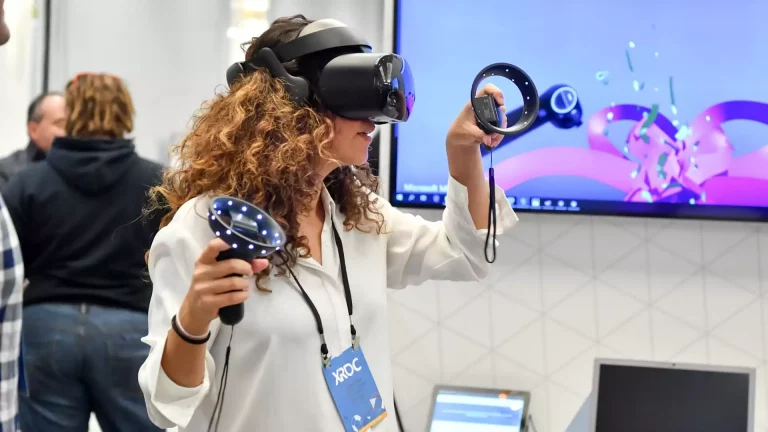
Remote work is here to stay, and companies of all sizes and types are experimenting with new technologies. For example, videoconferencing tools became increasingly popular as the COVID-19 pandemic progressed. By April 2020, Zoom hosted over 300 million daily meetings.
Other key technologies like artificial intelligence (AI) and virtual reality (VR) are emerging in various industries, from health care to retail and everything in between. VR, in particular, is expected to transform how we live and work. One application entering the spotlight is remote onboarding, which assists HR professionals with various processes.
Here’s a deeper look at the role of VR in modern onboarding and how successful companies are incorporating it into their operations.
An Overview of the VR in the HR Market
The global VR market is growing rapidly. ARtillery Intelligence projects it to exceed $28 billion by 2026. Companies will continue to invest in VR and integrate it into every aspect of their business model as the technology evolves.
More employees are working from home than ever before, and companies are facing several new challenges, such as:
- Encouraging a healthy work-life balance
- Keeping employees satisfied and engaged
- Maintaining connections among workers
- Transitioning to remote onboarding
Onboarding plays an integral role in the competitive business environment. Without an effective, solid program, new hires will feel lost, disconnected and helpless when they log on for the first time. A strong plan will help them feel more confident in their roles and enable them to hit the ground running.
Benefits of VR-Based, Remote Onboarding
VR is starting to play an increasingly important role in today’s HR departments due to its wide range of benefits. It enables new and existing employees to experience an immersive environment they may not otherwise have if they worked elsewhere or did not purchase a VR headset for personal use.
What are some benefits of VR in the workplace — specifically for remote onboarding processes?
- Helps keep employees engaged and interested
- Drives productivity and can shorten the amount of time needed for onboarding
- Meets social distancing or health guidelines
- Gives employees a better sense of workplace culture and social connection
- Provides interactive solutions that help employees retain information
- Offers flexible e-learning integrations
Every business leader was forced to adapt to the remote work trend, which presented new challenges. For example, the concern that employees are less productive at home is simply untrue. Statistics show that 89% of remote workers feel that their productivity remained the same or increased while working from home, something no business saw coming.
How Companies Can Use VR to Support Remote Hires
It’s crucial to comprehend current hiring trends and what HR professionals are currently working to fix to understand how VR can be used for effective onboarding.
Traditional onboarding programs consist of reading handbooks, attending long presentations and watching videos. Unfortunately, this type of training fails to keep people’s attention. New hires want to feel excited, eager to learn and engaged during the process. Implementing these basic strategies will have the opposite effect.
Incorporating VR-based onboarding can help companies manage and train their remote hires. What VR use cases regarding onboarding would benefit companies and workers?
Gamification
VR is often associated with the gaming industry, but it’s also carving out a place in today’s business world. A failed onboarding process will not bode well for new remote employees. Instead, gamify the process for recent hires. Consider investing in employee training software to show them you care about their experience.
Gamified VR will transform onboarding into a fun, engaging, entertaining and personalized experience for new employees. Companies can showcase company initiatives, ask questions to ensure workers retain information and more.
Functional Training
Onboarding new hires is essential to create a safe work environment in dangerous industries like mining, manufacturing and construction. Employees without proper training put themselves and others at risk of injury or fatality.
Leverage VR during onboarding for dangerous or laborious jobs. For example, a new employee training to use heavy machinery can leverage a VR-based training solution to practice using whichever equipment they’ll be responsible for.
Team Integration
VR and the emerging metaverse will provide businesses with opportunities to connect employees across departments and break down barriers to social interaction. Companies can use VR for team integration or assimilation, an integral part of the onboarding process.
Take Accenture, for example. The company recently introduced a virtual campus — called the Nth Floor — to use for onboarding hires and other purposes. New remote employees will feel more connected to other workers and the company by using these advanced technologies.
Leveraging VR to Onboard Remote Hires
The job market is extremely competitive, meaning every organization must present interesting onboarding experiences to keep high-quality candidates engaged. It’ll be interesting to see how VR becomes increasingly popular in HR departments for onboarding purposes.

Devin Partida is Editor-in-Chief of Rehack and editorial contributor at AR Insider. See her work here and follow her @rehackmagazine.

